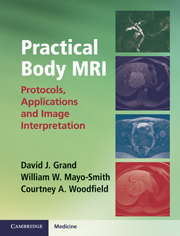Book contents
- Frontmatter
- Contents
- Preface
- To the reader
- Acknowledgments
- Glossary of terms andabbreviations used in Body MRI
- Section 1 Body MRI overview
- Section 2 Abdomen
- Section 3 Pelvis
- Chapter 7 The female pelvis: uterus
- Chapter 8 Adnexa
- Chapter 9 Female urethra
- Chapter 10 Pelvic floor / prolapse
- Chapter 11 Imaging of the pregnant patient
- Chapter 12 MRI of male pelvis
- Chapter 13 Rectal MRI
- Section 4 MRI angiography
- Index
Chapter 10 - Pelvic floor / prolapse
from Section 3 - Pelvis
Published online by Cambridge University Press: 05 November 2012
- Frontmatter
- Contents
- Preface
- To the reader
- Acknowledgments
- Glossary of terms andabbreviations used in Body MRI
- Section 1 Body MRI overview
- Section 2 Abdomen
- Section 3 Pelvis
- Chapter 7 The female pelvis: uterus
- Chapter 8 Adnexa
- Chapter 9 Female urethra
- Chapter 10 Pelvic floor / prolapse
- Chapter 11 Imaging of the pregnant patient
- Chapter 12 MRI of male pelvis
- Chapter 13 Rectal MRI
- Section 4 MRI angiography
- Index
Summary
Pelvic prolapse protocol
Indications
This protocol is used to evaluate disorders of the pelvic floor including pelvic organ prolapse and defecatory function. Indications include pelvic organ prolapse, urinary and fecal incontinence or retention, and possible enteroceles, sigmoidoceles, and rectoceles.
Preparation
IV contrast agent: None
Oral contrast agent: None
NPO for 4 hours prior to the exam
Have the patient void prior to the start of the study
120 cc sonography gel placed per rectum using 60 cc Tume syringe
Center patient on water-absorbent pad
Place cushion underneath the patient's knees
Center pelvic phased array coil slightly lower than usual on pelvis to cover the proximal thighs. Pelvic organs may descend during stress maneuvers.
Ensure patient understands how to perform Kegel and Valsalva maneuvers and understands the importance of evacuating the rectal contrast during the sagittal dynamic True FISP sequence.
- Type
- Chapter
- Information
- Practical Body MRIProtocols, Applications and Image Interpretation, pp. 99 - 105Publisher: Cambridge University PressPrint publication year: 2012



